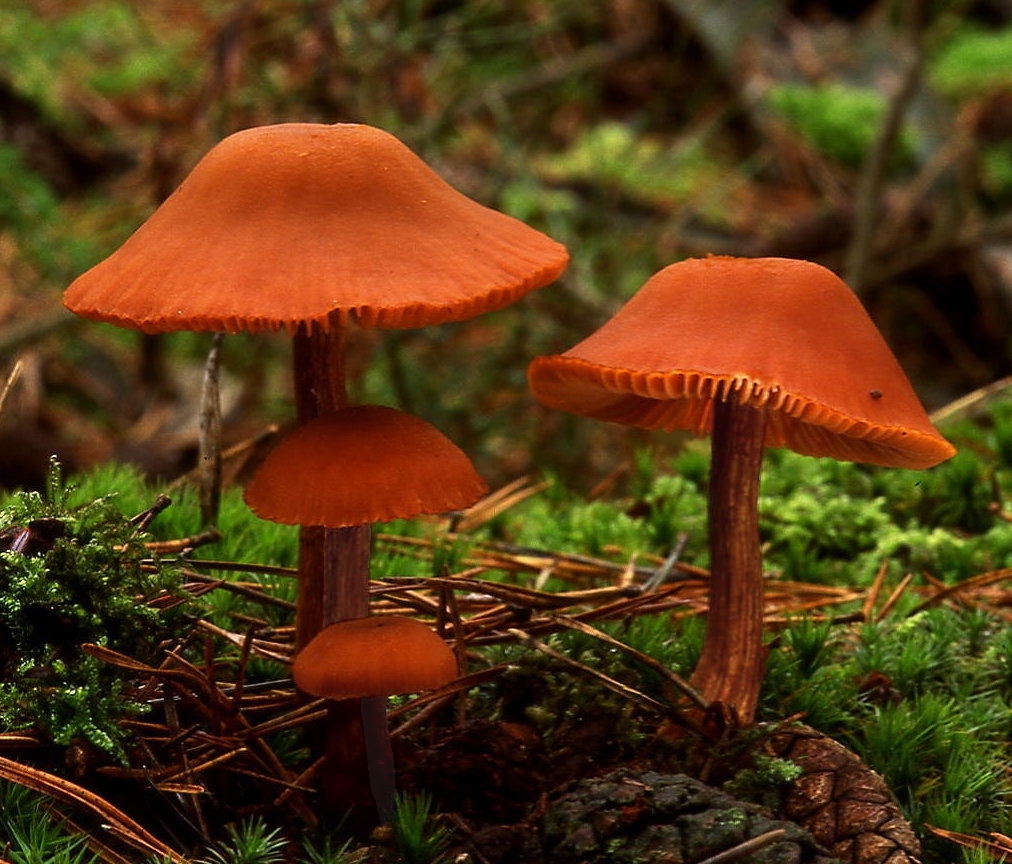- Laccaria laccata
Taxobox
name = "Laccaria laccata"

image_width = 250px
status = Common / safe
regnum = Fungi
divisio =Basidiomycota
classis =Agaricomycetes
subclassis =Hymenomycete s
ordo =Agaricales
familia =Hydnangiaceae
genus = "Laccaria "
species = "L. laccata"
binomial = "Laccaria laccata"
binomial_authority = (Scop.) Cookemycomorphbox
name=Laccaria laccata
whichGills=adnate
whichGills2=decurrent
capShape=convex
capShape2=flat
hymeniumType=gills
stipeCharacter=bare
ecologicalType=mycorrhizal
sporePrintColor=white
howEdible=edible"Laccaria laccata", commonly known as the deceiver, or waxy laccaria, is a white-spored species of small edible
mushroom found throughoutNorth America andEurope . It is a very variable mushroom (hence "deceiver"), and can look quite washed out, colorless and drab, but when younger it often assumes red, pinkish brown, and orange tones. The species is often considered by mushroom collectors to be a "mushroomweed " because of its abundance and plain stature.Taxonomy
The deceiver was first described by
Tyrol ian naturalistGiovanni Antonio Scopoli in 1772 as "Agaricus laccatus", [cite book | author = Scopoli, Giovanni Antonio | year = 1772 | title = Flora Carniolica|edition=2 |pages=p. 444] before being given its current binomial name byMordecai Cubitt Cooke in 1884. The specific epithet is derived from theLatin adjective "laccatus" "varnished" or "shining".cite book | author = Nilson S & Persson O | year = 1977 | title = Fungi of Northern Europe 2: Gill-Fungi | publisher = Penguin|isbn=0-14-063006-6|pages=p. 36] "Clitocybe laccata" is an old alternative name. Var. "pallidifolia", described byCharles Horton Peck , is the commonest variety found in North America.It is the type species of the cosmopolitan mushroom genus "Laccaria"; where their relations lie among the gilled mushrooms is unclear, but they are currently classified in the family
Hydnangiaceae .The deceiver gets its common name from its variable appearance. Other names include Lacklustre laccaria, and, by the
Zapotec people , "Beshia ladhi biinii" (also the name of other members of "Laccaria").Description
The deceiver is a small mushroom with a cap up to 6 cm (2.4 in) in diameter, convex when young and later flattening or even depressed in the center. It can be various shades of salmon pink, brick-red, or shades of orange or brown when moist or young, and duller and paler when dry. The fibrous stipe is 5-10 cm (2-4 in) high and 0.6-1 cm wide. The irregular gills are widely spaced and decurrent or adnexed, and of similar color to the cap, though whiten with spores as the mushroom matures. The
spore print is white, and the round spiny spores are 7-10 μm in diameter. The flesh is thin and has little taste.cite book | author = Roger Phillips | year = 2006 | title = Mushrooms | publisher = Pan MacMillan | isbn = 0-330-44237-6|pages=p. 102]Formerly considered a subspecies by French mycologist
René Maire , the close deceiver ("Laccaria proxima ") is a European relative with a fine scaly cap and found in wetter habitats.cite book |title=The Great Encyclopedia of Mushrooms |last=Lamaison |first=Jean-Louis |coauthors=Polese, Jean-Marie |year=2005 |publisher=Könemann |isbn=3-8331-1239-5|pages=p. 83] Microscopically, its spores are narrower and more oval-shaped.In California, what was thought to be "L. laccata" under
eucalyptus has turned out to be the Australian species "Laccaria fraterna ". [ [http://www.mykoweb.com/CAF/species/Laccaria_fraterna.html] ]Distribution and habitat
"L. laccata" is found in scattered troops in wooded areas, and on
heathland often in poorsoil . It is very common in all of the northern temperate zones, but tends to favor cool weather."L. laccata" ismycorrhiza l with several types oftree s, including members of thePinaceae (Pines),Fagaceae (Beech), andBetulaceae (Birch). It is found across Europe and North America,cite book |author=David Arora |year=1986 |title=Mushrooms Demystified |publisher=Ten Speed Press |isbn=0-89815-169-4|pages=p. 172] south into Mexico and Costa Rica. "Laccaria" species are mycorrhizal, and thought by some to be pioneer species.Edibility
Although small, the deceiver is edible and mild-tasting. However, it is important to distinguish it from potentially lethal small brown mushrooms. It is one of many mushrooms traditionally eaten by the
Zapotec people ofOaxaca in Mexico.cite journal |author=Garibay-Orijel R, Caballero J, Estrada-Torres A, Cifuentes J|year=2007 |month=January |title=Understanding cultural significance, the edible mushrooms case |journal=Journal of Ethnobiology and Ethnomedicine |volume=3 |issue=4 |pages= |doi=10.1186/1746-4269-3-4 |url=http://www.pubmedcentral.nih.gov/articlerender.fcgi?artid=1779767 (fulltext) |accessdate=2008-09-09]References
External links
* [http://www.fieldmuseum.org/research_collections/botany/botany_sites/fungi/species/L.laccata/mushroom.html "Laccaria laccata" var. "laccata"] at the
Field Museum of Natural History website
Wikimedia Foundation. 2010.
